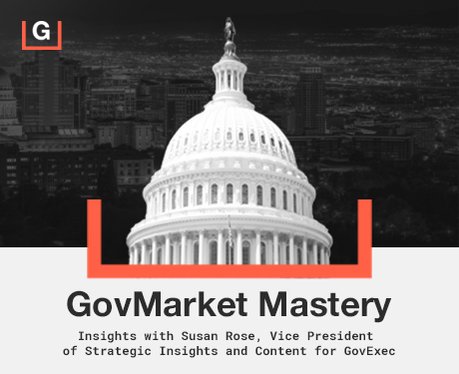Public sector marketers are no strangers to the perpetual challenge of achieving more with fewer resources, whether that be constrained budgets, limited time, or lean staff. That makes the promise of AI to support marketing efforts extremely enticing. Who wouldn’t want a plug-and-play solution?
But is AI truly the game-changer it's purported to be when it comes to B2G marketing? That was the question our panel of experts explored at the AI Marketing Strategy Workshop held in conjunction with GovExec’s Market Preview. Susan Rose, Senior Director of Insights and Content for GovExec, moderated the discussion. Melanie Holmes, Head of Public Sector Marketing for Adobe, and Janet Waring, CEO of Artform–both of whom are AI early adopters–shared their experiences and insights.
Strategic Implementation and Alignment
The workshop emphasized the critical importance of strategically implementing AI and aligning it with specific marketing goals. That is, where can AI best support your efforts? Rose, drawing from the Marketing for the Public Sector Content Marketing Review, shared valuable data to help marketers craft the right strategies and campaigns tailored to their objectives. Armed with these insights about what types of content will resonate for the audience, marketers can integrate AI into their plans, such as outlining research reports or repurposing content into different formats.
Reporting and Research
On the backend, Janet Waring advocated for using AI to navigate the ever-changing Google algorithms. AI-powered tools such as Bard and ChatGPT were highlighted for their prowess in keyword research, content optimization, and generating relevant keywords, providing invaluable assistance in improving search engine rankings.
Additionally, AI can help with analyzing data and generating reports. Tools like ChatGPT code interpreter can review data and provide insights and visualizations. However, Waring stressed (and the others agreed) that while AI is a powerful tool, human expertise remains indispensable to ensure the accuracy and relevance of content.
Waring also mentioned using prompt libraries for specific guidelines and suggestions for the desired tone, voice, and overall style of the content. For example:
- Writing a blog post: A prompt could be used to provide a specific style guide for the blog post, such as using a conversational tone, incorporating storytelling elements, or using a specific writing structure like a listicle or a how-to guide.
- Designing visual content: Prompts can guide the style of visual content, such as specifying the color palette, font choices, and overall aesthetic. For example, a prompt could suggest using bold and vibrant colors for a promotional graphic or a clean and minimalist design for an infographic.
Creative Development
Building prompt libraries is one facet of using AI to help with content creation. It can also help with marketing strategies and campaign execution. However, Holmes stressed the importance of ethically sourcing content, especially when it comes to creative elements like images. She also highlighted the Content Authenticity Initiative, which aims to address the provenance of content and protect artists' rights.
Primarily, Holmes is a fan of using AI in idea generation and content iteration, specifically in validating research, creating outlines, and transforming long-form assets into digestible content.
- Generate new ideas and variations for content. For example, AI-powered language models like ChatGPT can help in generating new blog post ideas, creating abstracts from white papers, or even suggesting relevant keywords for SEO optimization.
- Repurpose existing content into different formats. For instance, AI tools can help in transforming a blog post into a script for a video or creating shorter versions of long-form content for social media platforms.
- Improve the quality of content by providing feedback and suggestions. AI-powered tools can analyze the content and provide recommendations for improving readability, grammar, and overall effectiveness.
Ethical Considerations
The discussion expanded into the ethical considerations surrounding AI's generative creative capabilities to build representative imagery and videos. With this comes the caution (and hot-button issue) of the need for content authenticity and copyright protection — both of which ensure the integrity and originality of the content being used. Authentication helps verify the source and accuracy of the information, confirming that it is reliable and trustworthy. Copyright protection is crucial for safeguarding the rights of content creators and preventing unauthorized use or distribution of their work. By respecting copyright laws and using content from ethical sources, marketers can maintain credibility, avoid legal issues, and support the creative community.
All panelists agreed that having a solid AI policy and being mindful of ethics must be top of mind before using AI in marketing efforts. At a minimum, the policy should ensure all AI usage complies with applicable laws and regulations. This includes data protection laws, industry-specific regulations, and any standards related to AI and machine learning technologies.
The Human Element
AI tools can become the marketer’s best friend with a rather large caveat: they must be used correctly and ethically.
AI cannot replicate all the knowledge marketers have, and can make mistakes due to outdated or incorrect data. Holmes considers both of these facts “job security,” and emphasized the irreplaceable role of human input in areas like authenticity, differentiation, and understanding customer pain points. In the world of B2G marketing, AI should complement human expertise, not replace it.
AI: Your Favorite Intern
Troy Schneider, President of GovExec 360, likened AI to “a really eager and diligent intern that will do the grunt work, but needs oversight.” AI has the ability to streamline tasks, saving valuable time for strategic efforts.
The workshop shed light on the tremendous potential of AI in public sector marketing. As marketers embrace AI as a valuable ally, they must remember that, like a diligent intern, it requires guidance and observation. The future of B2G marketing lies in the synergy between cutting-edge AI technology and the timeless expertise of the human touch. And who knows, maybe one day AI will even be able to grab that coffee.

